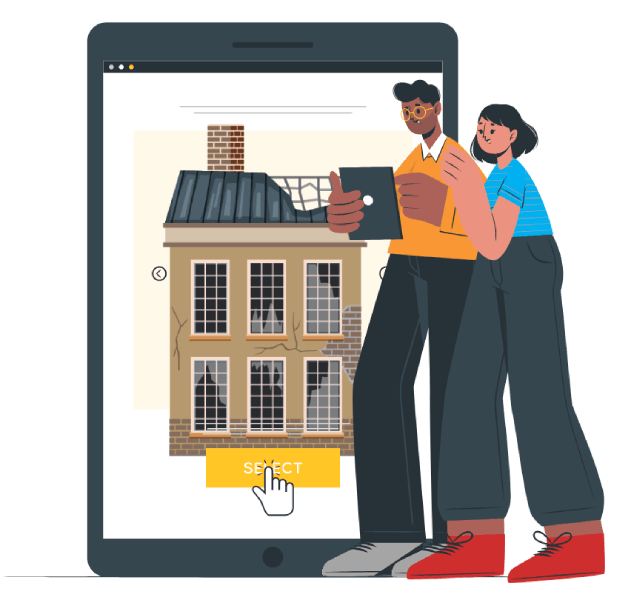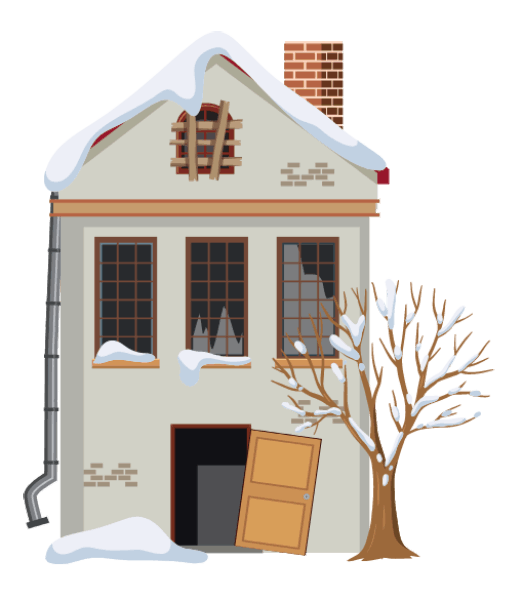Getting a mortgage on an uninhabitable property
How do you get a mortgage when the lender says the property is uninhabitable?
In this guide we explain what makes a property uninhabitable, the options regarding getting a mortgage and where to get further help.

Lender’s opinions do vary, but if you are interested in buying a property that does not have a working kitchen, or is structurally unsafe or has half the roof missing, you’re likely to receive a straight NO when you approach them.
Do they not know that this is a bargain and must be bought by any means possible?
Most mortgage providers don’t want to be bothered with financing run down properties, even if they are a bargain. They prefer nice warm, dry properties, that don’t have indoor water features, or pigeons or bats living in them.
Fussy lot.
But from time to time properties do come up for sale that need some TLC and are worth saving. Perhaps it is a good opportunity to move up the property ladder or maybe grab another investment property for the portfolio. Many of these types of houses are sold at auction, because they are missing some of their vital parts!
But a house without a roof or a bathroom still needs to be paid for. So keep reading as we explain how to mortgage an unmortgageable, uninhabitable residence.
What does uninhabitable mean?
The majority of lenders will understand that a property does not need to be perfect for it to be considered habitable. It should be warm and dry, protected from the elements and with basic facilities such as:
- Electricity
- Heating
- Running water
- Windproof and watertight
- Working kitchen
- Functional indoor bathroom and toilet
It’s equally possible that all or most of the above are present but the lender still won’t accept anyone can live there.
Some of the additional reasons could be:
The property has suffered fire damage
Fire damage can compromise the structural integrity and safety of a property, making it difficult to secure a mortgage. Lenders will require a full assessment of the damage, along with a plan for repairs or rebuilding before considering a loan.
Inadequate hot and cold water supply
A reliable and functional hot and cold water supply is a basic requirement for a habitable property. Lenders may be hesitant to offer a mortgage if there are major issues with the water supply.
Complications with the drains
Proper drainage and functioning toilets are vital for sanitation and hygiene in a home. Lenders will want to ensure that these systems are in good working order before granting a mortgage.
The presence of asbestos or mould
Asbestos and mould are hazardous and can pose significant health risks and affect the property’s value. Lenders are wary of offering mortgages on properties with these issues, as their removal and remediation can be costly and complex.
Why do these issues affect the mortgage?
A property labelled as ‘uninhabitable’ will not have sufficient basic amenities so that someone could live there.
This is a problem for mortgage lenders.
They rely on their ability to repossess a house if the borrower defaults on the mortgage payments. The lender takes control of the property and then sells it to pay back their loan.
But who wants to buy a house that they cannot live in?
This means the lender has a very small number of potential buyers and the price received is likely to be quite low. There is a chance that the property sale does not even generate enough money to repay the loan.
And for many lenders this risk is too high.

How does the lender know?
Lenders rely on expert valuers to assess a property’s condition and determine its habitability. The valuer conducts a thorough inspection, evaluating the property’s overall state, and prepares a detailed report for the lender. This report is a crucial component in the lender’s decision-making process, as it provides an impartial, expert opinion on the property’s condition.
The surveyor will be aware of that particular lender’s criteria for a property and will tailor their report accordingly. They will also know the type of mortgage being applied for: residential mortgage, buy to let, holiday let.
Each of these have their own requirements from a property, which the surveyor will report back on.
Can you get a mortgage on an uninhabitable property?
Yes, mortgages are available. But this could take some time, so make sure you are ready for the challenge.
Banks and building societies that offer long term mortgages want the property to be in a liveable condition when completion takes place. This is the expectation of all mortgage lenders when offering a ‘standard’ mortgage.
So you either need to think outside the box or look for other ideas.
If you deal with the right broker then you will have suitable options. The lender’s opinion will very much depend on the state of the property and how much work, or money, is needed to bring it up to their minimum standard. This means that every mortgage case is unique and so with the help of your mortgage adviser, you will be able to approach lenders that are more understanding of the situation.
What the lenders say
Condition
The property must meet minimum criteria.
It must be habitable, readily saleable, structurally sound and be able to have buildings insurance arranged upon it. We do not offer retentions. We will not provide a valid offer until any works considered essential by the Valuer are completed and confirmed as satisfactory.
We do not consider mortgage lending where a property is
uninhabitable.
Definition of uninhabitable: A property that does not have an internal
working kitchen or bathroom.
Unacceptable properties
We will not provide residential mortgages for:
- House boats
- Mobile homes
- Bed and breakfast properties
- Properties with agricultural ties
- Construction of a new property
- Conversion to/refurbishment of a residential property (home improvements excluded)
- Non-habitable properties (without a working kitchen and bathroom)
- Residential properties which are used wholly for commercial purposes
- Live/Work units
- Overseas properties
- Holiday homes that cannot be lived in all year round
Unacceptable Properties
- No internal bathroom and W.C. or kitchen.
- Liable to be subject to clearance or compulsory purchase order.
- Freehold flats and maisonettes.
- Isolated rural properties with restricted access and services.
- Office to residential conversion
- Residential property divided into bed sitting rooms.
- Pre-cast re-enforced concrete properties, designated under the Housing Act 1985, part xvi, unless they have been repaired by PRC Homes Ltd, a subsidiary of the NHBC.
- Studio Flats
- Flats with balcony access i.e. access via covered walkway.
- New build maisonettes/apartments/flats where the LTV exceeds 90%
- Live/Work properties.
- Shared ownership
- Shared Equity (Help to Buy scheme permitted)
- Right to Buy
- Local Authority multi storey blocks (Some properties may be considered in certain locations, please contact your BDM)
- Timeshare accommodation
- Holiday Homes
- Dwellings of totally timber construction i.e. not clad with brick, stone etc, including the log cabin/chalet type of construction
- Single brick (single skin) construction
- Partially built property
- Properties with restrictions in place that would affect future marketability and resale value
- City Properties with self-contained basement units which are (or are to be) let out
For all applications the property must be habitable with a working kitchen and bathroom (as a minimum) before any funds will be released.
Non Habitable Condition
Not accepted – property has to be secure; structurally sound; insurable; have a working kitchen with running water, storage and ability to heat food; have a working bathroom with working lavatory, sink and ability to shower or bath and subject to surveyor’s comments.
Property Condition
The property must meet minimum criteria. Must be habitable, readily saleable, structurally sound and be able to have buildings insurance arranged upon it. The mortgage advance may be wholly or partially retained pending completion of works required to bring the property to a suitable condition for lending.
Mortgage eligibility
All mortgages will have some basic eligibility requirements.
Some of these are:
Deposit: You’ll need 10% or more as a mortgage deposit.
Credit profile: Get a copy of your credit report and make sure everything looks OK.
Affordability: As normal, the lender will ask for proof of your income and will then undertake an affordability assessment, which takes your outgoings into consideration.

Mortgage alternatives for an uninhabitable house
Sometimes, the condition of a property is so poor that it’s not possible to obtain a long term mortgage from any lender. In these situations you need to find an alternative way of borrowing the money needed.
This now means that there are two stages to the financing side of buying your uninhabitable property:
The initial purchase
First you need money to cover the purchase costs, and probably the renovation costs.
Bridging loan: A bridging loan can be used to finance a large proportion of the purchase price, anything up to 75%. The lender will be keen to understand your renovation plans and where the cost of this is coming from. Generally there’s no monthly payments, all interest and fees are paid on final settlement. Bridging loans are also available as a second charge, so can be used for main residence and/or buy to let, holiday let.
Second charge: If you own your home, or perhaps have an investment property, it may be possible to apply for a second charge mortgage and borrow against the property equity. This could put your own home at risk.
Remortgage: Again this could apply to your home or a buy to let house. A capital raising remortgage can be used to borrow some extra money, but this will depend on the available equity. Look carefully at any mortgage exit fees before rushing ahead.
Refinancing
Bridging and second charges are more expensive than a long term mortgage, so it’s sensible to repay these from a standard remortgage at the earliest opportunity.
Once your new property is habitable (according to the lender’s surveyor), you will be in a position to apply for a remortgage. A remortgage is needed if you already own the property concerned. Your broker will be able to explain the process but the aim would normally be to get a mortgage that fully repays any extra borrowing you needed in Stage 1.
Once the remortgage has been completed your finances should be a lot simpler, along with a cheaper mortgage arrangement.
There may be added complications if you try to remortgage before owning the property for six months. It’s a restriction that some, but not all, mortgage lenders have in place. Learn more:

Bridging Loans Guide
In this guide, we will provide an overview of bridging loans and offer some tips on how to get the best deal for short term finance.

Remortgage Guide
Our Guide covers the remortgage process, including how long it takes, and the different options you have when switching your mortgage.

Mortgage Broker Guide
In this guide we’ll take a look at what mortgage brokers do, how they can help you, how they get paid plus tips on how to find a good one.
How can a mortgage broker help?
Your choice of lenders for these types of properties is very limited and almost none of the high street banks will be able to help, at least initially.
An independent mortgage broker will have access to over 100 banks and specialist lenders, many of whom will only work with a broker.
They will be able to identify the key issues that a lender will be concerned about, and then start to build a list of potential sources of finance.
It’s highly probable that your broker will need to informally discuss your property with an underwriter before the need for a full mortgage application. This is helpful as it saves time, money and reduces the chances of an application being declined.
And don’t forget your broker will be assisting with queries and advice while your mortgage is being set up.

CONTACT A MORTGAGE BROKER
If you are ready to take the next step then we can put you in touch with a fully qualified independent mortgage broker.
Regulated and unregulated mortgages explained
How you are using, or how you intend to use, a property, will determine whether it should be covered by the FCA. Your mortgage broker will be able to tell you if your mortgage will be regulated or unregulated.
This will then affect the lenders that you can approach and some of the borrowing options.
Are second charge mortgages regulated?
Are bridging loans regulated by the FCA?
Here’s a quick overview:
REGULATED
You are buying a property for you, or your close family, to live in or securing any loan against your home.
The lender (who must also be regulated) will need to conduct affordability checks.
Bridging loans have a maximum period of 12 months.
Protected by the FCA consumer regulations.
UNREGULATED
You are buying a property as an investment, and no part of the loan will be secured against your own home.
You will still need to provide proof of minimum income but affordability is less important.
Bridging loans can be for 3-36 months.
Not protected by the FCA consumer regulations.

FREQUENTLY ASKED QUESTIONS
According to Leeds Building Society, there are over 676,000 empty homes in England.
They state that in 2022 there were 676,452 empty homes in England, an increase of almost 23,500,
or 3.6%, over the previous twelve months. Of these, 248,633 homes are classed as
long-term empty properties, having been empty for over six months.
There is a clear north/south divide when looking at the number of empty homes as a
percentage of the total regional housing stock: despite having the smallest absolute
number of empty properties, the North East has the highest percentage of empty
properties at 3.3%, while London has the lowest percentage at 2.4%.
Why do some homes remain long-term empty?
In most parts of the country, the housing market works well, and empty properties are sold or
let again relatively quickly. However, some homes remain empty for long periods, usually due
to the personal and financial position of the owners, for example:
- Inheriting a property – the new owners may take some time deciding what to do with it
or will try and improve the property before selling it. - A previously rented property may require substantial repairs before it can be re-let, but
the landlord has not got the financial means to do this. - People or companies have bought properties to redevelop, but they are taking their
time to complete the work. - Owners are unable to fund the repairs and therefore have no choice but to leave the
property empty. - Properties once outlined for demolition but have been left empty due to changes in
legislation. Local authorities are not then able to fund the redevelopment. - Owners are holding onto the property hoping for a rise in the local market before trying
to sell the house. This is called ‘Buy to Leave’ and is sometimes an issue in areas where house prices tend to rise quickly, for example, London
A lender will occasionally hold back a part of the mortgage until specific problems are resolved. This is called a mortgage retention.
A retention is essentially a safety net for lenders. It ensures that the property is worth the amount they are lending, and that any urgent repairs or improvements are carried out before the full amount is released. This helps protect the lender’s security.
So, how does this impact you? Well, it means you may need to find additional funds to cover the cost of the repairs before the lender releases the retained amount. Once the work is done and the surveyor re-inspects the property, the lender will release the rest of the mortgage funds.
The simple answer is yes. In fact, this is one of the reasons bridging loans exist. They’re specifically designed to accommodate the unique challenges that come with purchasing properties in poor condition.
Bridging loan lenders are more concerned with the property’s potential than its current state. They’ll assess factors such as the location, the borrower’s experience in property development, and the proposed exit strategy. As long as you can demonstrate a clear plan to refurbish the property and have a realistic timeline to make it habitable, you should be able to secure a bridging loan.
Before you jump headfirst into applying for a bridging loan, there are a few things to keep in mind:
- Interest rates: Bridging loans come with higher interest rates than traditional mortgages, so be prepared for the increased cost.
- Exit strategy: Ensure you have a solid exit plan, such as refinancing with a traditional mortgage or selling the property once it’s habitable.
- Renovation costs: Don’t underestimate the cost and time required to refurbish the property. It’s crucial to budget accordingly and factor in potential delays.
- Specialist lenders: Not all lenders offer bridging loans for uninhabitable properties, so it’s important to find a specialist who understands your needs.
When assessing a property’s habitability, mortgage lenders typically consider factors such as safety, sanitation, and structural integrity. An uninhabitable property might have a severely damaged roof, major plumbing issues, or serious safety hazards. Although having no hot water is certainly inconvenient, it doesn’t automatically render a property uninhabitable.
Mortgage lenders have varying criteria when it comes to habitability. Some may consider a property without hot water to be uninhabitable, while others might not see it as a major issue. In most cases, it’s at the lender’s discretion to determine if the absence of hot water is a deal-breaker.
If you’re considering a property without hot water, it’s essential to understand the cause of the problem. Is it a minor issue, such as a faulty (or missing) boiler, or is it indicative of more significant plumbing problems? If the whole plumbing system has been condemned, then this will cause concerns for the lender.
Before moving forward with a property that lacks a boiler, it’s crucial to understand the implications.
Is the absence of a boiler a minor inconvenience, or does it signify more significant issues with the property’s heating and plumbing systems? Evaluating the situation will help you decide whether pursuing the property is worthwhile and whether a lender might consider it uninhabitable.
If the opinion is that a boiler needs to be installed, with no other major work, the lender will most likely be OK.
To get a mortgage approved the property needs to be weatherproof with a property maintained roof. If the roof is known to be leaking then a lender could decide to decline your application on the basis that is is uninhabitable.
You won’t be able to get a standard mortgage if the property lacks either a kitchen or bathroom. Specialist lenders can help and a bridging loan would be an option in this situation.
Yes, you can use a bridging loan to buy a property and this is a popular options when buying at a property auction.
A bridging loan is a short-term financing option designed to “bridge” the gap between the need for immediate funds and the arrangement of long-term financing. It’s commonly used in property transactions when buyers need to secure a new property before selling their existing one or when they encounter delays in mortgage approval.
However, keep in mind that bridging loans typically come with higher interest rates and fees compared to traditional mortgages, so it’s essential to weigh the costs and benefits before opting for this financing solution.
When you buy at a property auction you need to be able to get to legal completion within 28 days. It’s not normally possible to do this with a standard mortgage.
But bridging loans can be arranged quickly, with the opportunity to pick up bargain properties that are currently not able to be lived in.
Mortgage lenders will repossess (take back) a house if the homeowner stops paying their mortgage. These banks don’t want to keep them and will look to sell them as soon as possible, often at a discount.
When buying a repossessed house you need to carefully look at the condition and style of construction before committing to buy. You won’t have the luxury of asking the owners.
It’s inevitable that some of these houses will have fallen into disrepair and have been recently neglected. Also, check whether the main services are connected (water, electricity, gas) as it’s common for these to have been disconnected due to non-payment.
If you are fortunate enough to be gifted a house in someone’s will, you might want to check the mortgage situation before you celebrate your windfall.
Mortgages don’t just disappear when the property owner passes away. They will be included in the ‘gift’ of the house and the new owner (you) will then be liable for the mortgage repayment.
The problem here is that at some point you will need to formally get the mortgage transferred into your name. If you would also like to release equity from your inherited house then any new lender will want to know that the property is well kept and habitable.
Yes, of course.
These restrictions only come from the lenders and their criteria. If you are able to purchase a property for 100% cash then it will not matter what condition the house is in, or what amenities are working.
Where subsidence is an existing problem, none of the long-term mortgage lenders will be interested.
Underpinning a house is the recognised remedy for most subsidence issues. So you would use a bridging loan for the initial house purchase. Then get the underpinning done, checked and certified. Then get an underpinned property mortgage to pay off the bridge.
Read more: Buying a House With Subsidence

